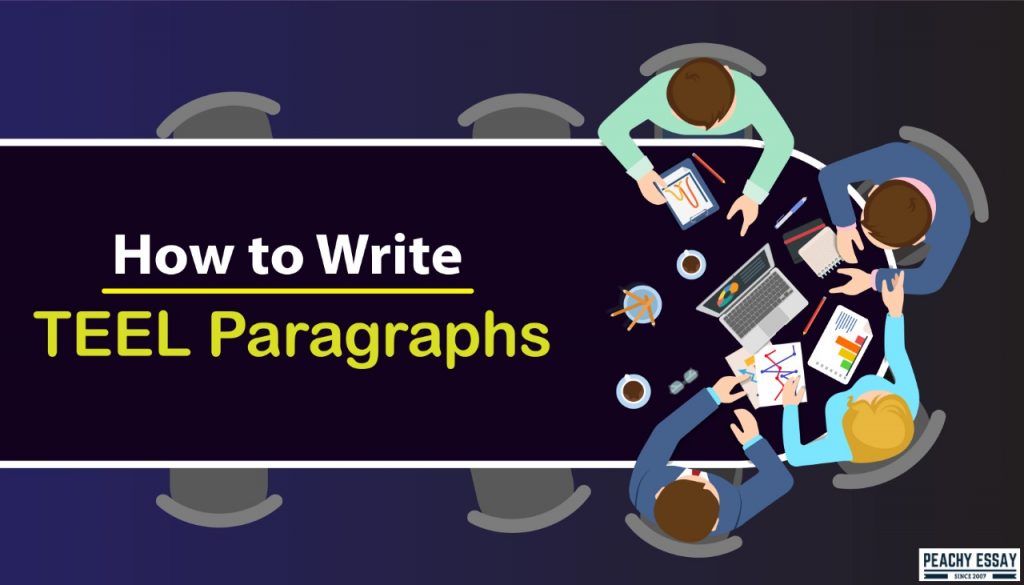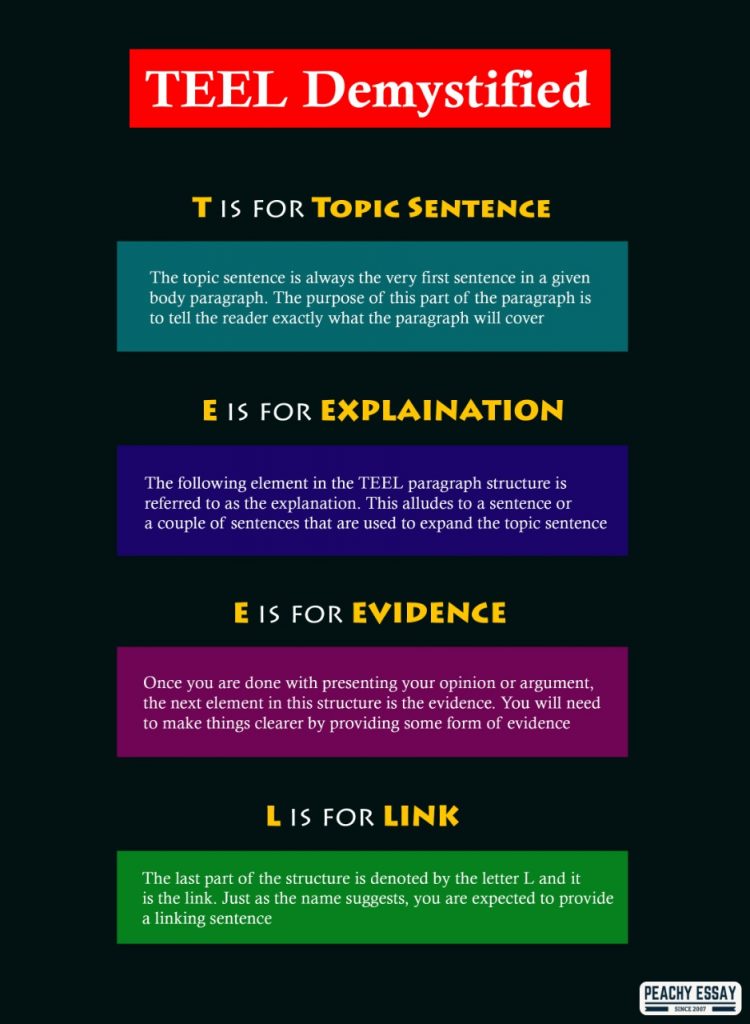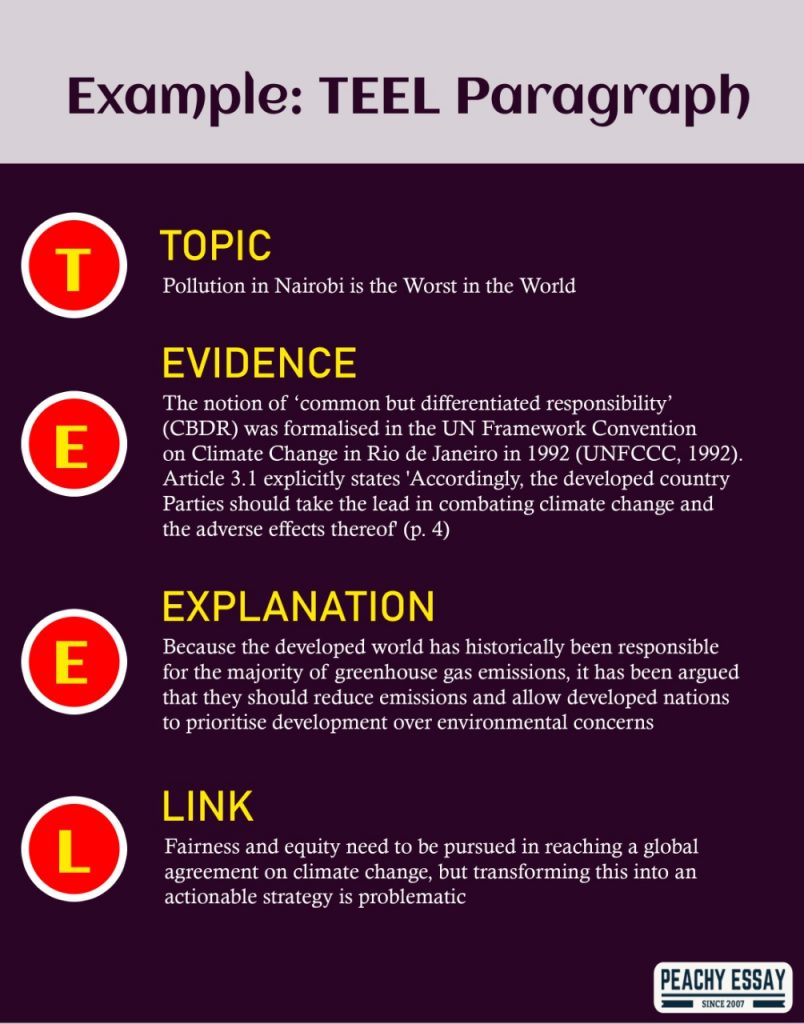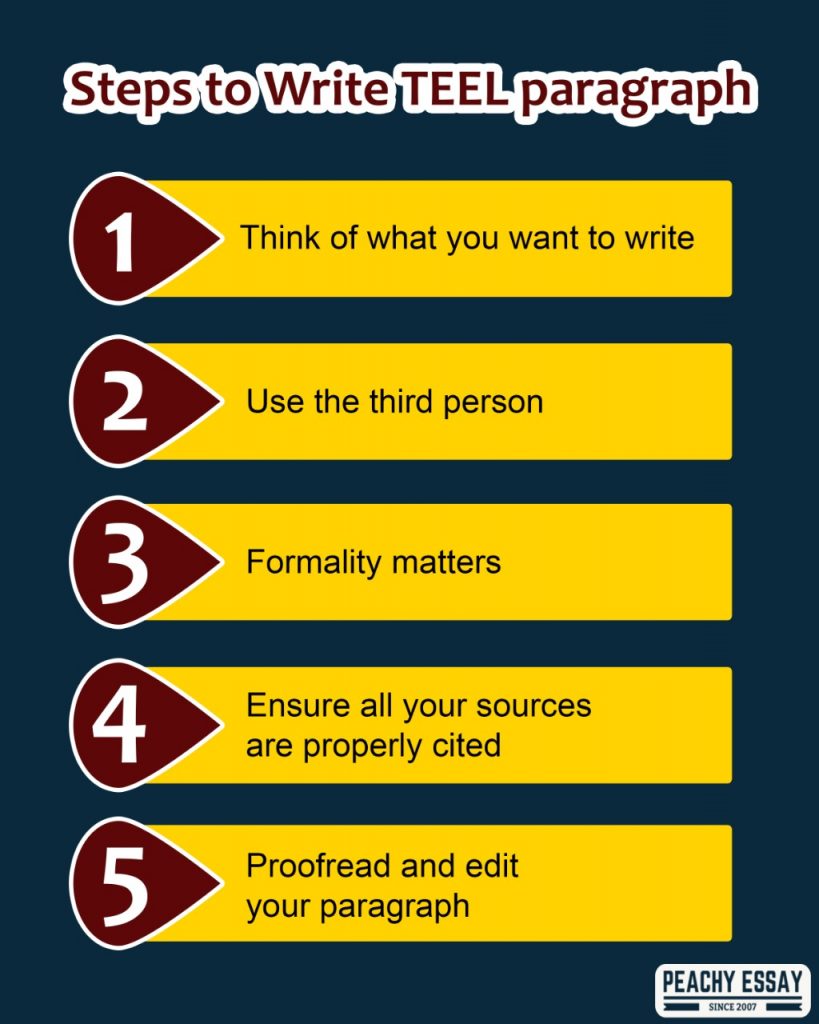Writing up a perfect essay is a task that requires more than a few hours of your time and a great deal of research. There many factors to consider and you need to ensure that you are well prepared for the task at hand. Although you may have a few years of experience composing academic papers, there are always many new things to learn and it is important that you stay open-minded. While many of us understand that the common essay structure is composed of an intro, body paragraphs and conclusion, very few of us know that the body paragraphs also have a structure. You do not write words on paper and assume that they will bring out your intended meaning. Instead, you need to think out the entire process and use a very neat structure to write these body paragraphs. Remember that the lack of a proper structure will make your work complex and hard to comprehend. Before we jump into detail, it is important that we first define the basic terms and try and understand how the TEEL paragraph structure functions towards the creation of better essays.
What is a TEEL Paragraph Structure?
Have you ever read a properly written essay that you found interesting and easy to understand? Was the intended message clearly communicated throughout the writing and did you find the structure of the body paragraphs interesting? Without knowing it, you may at one point interacted with a TEEL paragraph structure. By definition, the TEEL paragraph structure in essay writing alludes to an abbreviation or short form of the basic structure of a body paragraph. Ideally, one is expected to write in an organized manner so that it becomes easier for your audience to read and understand your work as the length of your essay grows. The TEEL paragraph structure can thus be defined as a structure that makes use of a topic sentence, an explanation, evidence, and a link that summarizes the paragraph in a sentence and links it back to the key terms of the essay topic.
A good format creates a great opportunity for you to disseminate your information in a concise form that gives your target audience stress-free time as they read your work. This structure is made up of four different parts that are all represented by one of the individual letters. From TEEL, we are going to explore each of these unique parts individually in the next section. When you combine the four elements of the TEEL structure in the proper order, you are able to have a well-formed and easy to read a paragraph.
Teel Paragraph Structure
You are probably asking yourself, what is a TEEL paragraph structure in essay writing?
To get a clearer picture of what the TEEL paragraph structure entails, we are going to explore each of the important sections of a TEEL paragraph individually. Although it may sound complex at the start, understanding how to effectively use the PEEL paragraph structure is an effective way to improve your writing. Most good writers are well-versed with using this structure and always implement it quickly in their essays. You may not notice it outwardly as you read an essay unless you have interacted with it, but most papers employ this wonderful technique. Let us now see what each of the important sections of a TEEL paragraph contain.
As I explain the TEEL structure, I will make use of a great example of an essay submitted in the past.
Topic Sentence denoted by the Letter T
The topic sentence is always the very first sentence in a given body paragraph. The purpose of this part of the paragraph is to tell the reader exactly what the paragraph will cover or the arguments that you, as the writer, intend to make in that paragraph. By the time that your audience has completed reading this sentence, they are expected to have a clear idea of what will be discussed in that paragraph. This element of the TEEL paragraph is expected to provide an argument and is also expected to directly relate to the main topic of your essay.
Let us explore some examples of topic sentences:
Example 1: There are many reasons why pollution in Nairobi Town is the worst in the world.
In this case, the topic is ‘pollution in Nairobi is the worst in the world’ and the main or controlling idea is ‘many reasons’.
Example 2: To be a good leader requires certain characteristics.
The topic is ‘to be a good leader’ and the main idea is ‘certain characteristics.’
Coming up with a properly stated argument
The topic sentence or your first sentence in the paragraph should not simply be a factual statement. A factual statement is a closed piece of information that does not require any more evidence or examples to support it. The topic statement should be more of an argumentative statement that will need more evidence and examples to support it. When you use a factual statement as your opening statement, you limit your ability to expound on the topic which is a grave mistake in essay writing.
Let us explore an example of argumentative and factual statements:
Argumentative: One of the main obstacles to reaching international consensus on climate change action is the ongoing debate over which countries should shoulder the burden.
Factual: No single country wants to shoulder the burden of climate change.
Each of the body paragraphs that you include in your essays needs to begin with a good argumentative topic sentence. When you use such a topic sentence, not only do you grab the attention of your readers, you also place yourself in a better position to better explain your arguments and include evidence to support your claims.
Explanation denoted by the letter E
The following element in the TEEL paragraph structure is referred to as the explanation. This alludes to a sentence or a couple of sentences that are used to expand the topic sentence. In this part of the paragraph, you are expected to offer an explanation of what you mean in more detail. You are also supposed to give your argument more focus. In this portion, you can make use of some of your factual statements and supporting information that you cannot include in your topic statement.
You need to ask yourself what you are trying to argue and put it into detail. You need to show your audience what you mean through your explanation. The best way to do this part of the paragraph well is to assume that your audience is completely clueless about your topic of discussion. When you present your topic sentence to that audience, they are still unsure about what you mean. With this in mind, you need to take your time in one or two sentences to clearly explain what you mean in more detail, why you think it’s important, and why you are trying to argue.
Let us now return to the previous example.
Example: Because the developed world has historically been responsible for the majority of greenhouse gas emissions, it has been argued that they should reduce emissions and allow developed nations to prioritize development over environmental concerns.
Evidence, denoted by the letter E
Once you are done with presenting your opinion or argument, the next element in this structure is the evidence. You will need to make things clearer by providing some form of evidence (usually attained through research) which will show your audience that you are right. The most common way of doing this part is by providing a quote from your source.
Try and think about your claim and the proof in your hands that your claim is right. Think of the part in the text that best supports your argument. Consider the part of the text that made you think that your argument is justified. You can do this by using examples from different sections of the text. You can then quote those sections or include a reference depending on the writing style that you are using in your essay.
Think of the above example
Evidence: The notion of ‘common but differentiated responsibility’ (CBDR) was formalised in the UN Framework Convention on Climate Change in Rio de Janeiro in 1992 (UNFCCC, 1992). Article 3.1 explicitly states ‘Accordingly, the developed country Parties should take the lead in combating climate change and the adverse effects thereof’ (p. 4).
Before moving to the last part of the structure which is the Link, always ensure that you make consideration of the strengths and weaknesses of the evidence/examples that you have used. Offer a good explanation of how your evidence supports the claim that you made in the topic sentence.
Example of a consideration: However, because CBDR outlines a principle and not an actionable plan it has remained problematic. For example, it does not stipulate the extent to which, under the principle of CBDR, developing nations should be exempt from specific emissions targets. This has continued to be a point of contention in global negotiations on climate change, with developed countries such as the USA arguing that developed nations should do more to reduce emissions (Klein et. al., 2017).
Link, denoted by the letter L
The letter L denotes the last part of the structure, and it is the link. Just as the name suggests, you are expected to provide a linking sentence. This is simply a sentence that gives a summary of the entire paragraph and links it back to the main topic. This sentence is almost similar to the topic sentence and needs to connect everything stated to the main topic of your essay. It should also offer a mini-conclusion of the evidence that you gave in your paragraph.
Let us look at an example.
Link: Fairness and equity need to be pursued in reaching a global agreement on climate change, but transforming this into an actionable strategy is problematic.
Practice makes perfect and you need to put in some amount of work to master this structure. It is, however, a commonly used structure, and you should endeavour to make sure that you fully understand how to use it in all your essays.
TEEL Paragraph Structure Outline
Since we are now clear on the elements of the TEEL structure, coming out with an outline should be very easy. Just as the name TEEL suggests, we can use the letters to remember how to use the paragraph in all our essays. The TEEL paragraph structure for essay writing is easier to remember since each of the letters acts as a good guide on what we are supposed to do. In essence, the outline would involve;
- Coming up with a great topic sentence that allows you to argue your main idea.
- Coming up with a good explanation that clearly expands your topic sentence and explains makes it clear to your audience by offering more detail.
- Giving proper and well-researched evidence for your explanation that shows the audience that your arguments and explanations are well-grounded.
- Providing a consideration that shows the strengths and weaknesses of your evidence
- Linking the entire paragraph to the topic sentence
In your outline, you should always ensure to note the main ideas that you plan to present. The based way is to make some notes as you move through each part of the paragraph. As you learn how to write better, you will find outlines much easier and faster to achieve and you will not have to struggle too much to get them done effectively.
Why is a TEEL Paragraph structure used in Essay Writing?
You may wonder why different people use different techniques as they are writing essays. You may also wonder why different writers prefer certain kinds of paragraphs to others as they create their work. We all adopt different writing techniques based on the needs and desires of our audience. The types of paragraphs that we create are also determined by the type of essays that we are expected to write as well as the instructions provided by our different instructors. As you advance on the educational ladder, you will also realize that you may need to change your writing techniques to make your essays more specialized and readable.
The TEEL paragraph structure is used in essay writing simply because it provides a great and effective way of organizing a paragraph. When you use this structure, you are able to fully develop your argument. Each of the paragraphs that you write are unique and encompass a key idea or claim that you are able to support using relevant examples and evidence from your research. Using this technique, you are able to tell your reader your main claim, give an explanation in greater detail, and offer evidence to support your claim, give consideration of the strengths and limitations of the evidence, and summarize the main idea of your paragraphs and how it supports the main essay topic.
In essay writing, this can be quite challenging to achieve especially if you do not have a proper structure in mind to guide you through the writing process.
How to Write a TEEL Paragraph
As seen above, the main purpose of a TEEL paragraph structure is providing a great and effective way to organize your paragraph. If you have a clear understanding of the important sections of a TEEL paragraph, it should not be so difficult to create one. In cases where you are stuck, you can always seek professional help from a Peachy Essay, the best essay writing company on the globe.
The TEEL paragraph for essay writing can be made easy to create by using the following steps:
- Think of what you want to write
Before diving into the writing, always take a few minutes to think about it and jot down your main ideas. Always include a summary of all the information that you wish to include in your paragraph following the TEEL format. Consider what you want to say, the evidence available, and how the information that you have connects to the main point.
- Use the third person
Most of the essays that employ this structure are formal in nature. Unless instructed not to do so, always make use of the third person voice since it’s more efficient. This rule, however, does not apply when writing college application and personal essays.
- Formality matters
When using this structure, always express yourself in a formal manner to help your writing sound and flow better. It will also sound more credible when you use a formal tone.
- Ensure all your sources are properly cited
In cases where you use quotes as evidence to support your claims, make use of quotation marks to show that you are using words as written by another person. Also, make sure that you indicate the source of information used using the right referencing technique.
- Proofread and edit your paragraph
After writing your paragraph, take some time to read through it and ensure that it flows logically. Ensure that the paragraph makes sense and that it is free of any errors. When you read and edit the paragraph, it essentially makes your whole essay better and easier to read.
Since we have all the details on writing a TEEL paragraph, let us finish the article by looking at an example of a well-written one for reference purposes.
Example of a TEEL Paragraph
We can combine the different elements of the TEEL paragraph that we used above as follows.
One of the main obstacles to reaching international consensus on climate change action is the ongoing debate over which countries should shoulder the burden. Because the developed world has historically been responsible for the majority of greenhouse gas emissions, it has been argued that they should reduce emissions and allow developed nations to prioritise development over environmental concerns. The notion of ‘common but differentiated responsibility’ (CBDR) was formalised in the UN Framework Convention on Climate Change in Rio de Janeiro in 1992 (UNFCCC, 1992). Article 3.1 explicitly states ‘Accordingly, the developed country Parties should take the lead in combating climate change and the adverse effects thereof’ (p. 4).
However, because CBDR outlines a principle and not an actionable plan it has remained problematic. For example, it does not stipulate the extent to which, under the principle of CBDR, developing nations should be exempt from specific emissions targets. This has continued to be a point of contention in global negotiations on climate change, with developed countries such as the USA arguing that developed nations should do more to reduce emissions (Klein et. al., 2017).
Fairness and equity need to be pursued in reaching a global agreement on climate change, but transforming this into an actionable strategy is problematic.
The above paragraph is an example of a good TEEL structure as used by a writer. You can use the given steps and example to effectively learn how to create TEEL paragraphs in all your essays.










